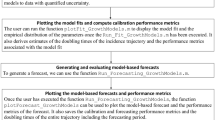Abstract
The Verhulst and Gompertz models were used for approximation of some well-known time series of Paramecia caudatum population dynamics (G.F. Gause, “The Struggle for Existence,” 1934). The parameters were estimated for each of the models in two different ways: with the least-squares method (global fitting) and a non-traditional approach (the method of extreme points). The results were compared with those presented by Gause. Deviations of theoretical (model) trajectories from experimental time series were tested using various non-parametric statistical tests. It was shown that the estimates by the least-squares method lead to results that do not always meet the requirements that are imposed on a “fine” model. However, in some cases a small modification of the least-squares-method estimates is possible that allows satisfactory representations of an experimental data set for approximation.
Similar content being viewed by others
References
G. F. Gause, The Struggle for Existence (Williams and Wilkins, Baltimore, 1934)
G. F. Gause, Zool. Zh. 12 (3), 170 (1933).
G. F. Gause, Zool. Zh. 13 (1), 18 (1934).
G. F. Gause, Byull. Mosk. O-va. Ispyt. Prir., Ser. Biol. 43 (1), 69 (1934).
G. F. Gause and A. A. Vitt, Izv. Sib. Otd. Akad. Nauk SSSR, 10, 1551 (1934).
P. F. Verhulst, Corresp. Math. Phys. 10, 113 (1838).
V. Volterra, Mathematical Theory of Struggle for Life (Nauka, Moscow, 1976) [in Russian].
V. Volterra, Leçons sur la théorie mathématique de la lutte pour la vie (Gauthiers-Villars, Paris, 1931).
A. I. Lotka, J. Am. Chem. Soc. 42 (8), 1595 (1920).
A. I. Lotka, Elements of Physical Biology (Williams aand Wilkins, Baltimore, 1925).
B. Gompertz, Phil. Trans. R. Soc. London 115, 513 (1825).
Yu. M. Svirezhev, Nonlinear Waves, Dissipative Structures, and Catastrophes in Ecology (Nauka, Moscow, 1987) [in Russian].
M. L. Rosenzweig, Am. Nat. 103, 81 (1969).
M. L. Rosenzweig and R. H. MacArthur, Am. Nat. 97, 209 (1963).
L. V. Nedorezov and Yu. V. Utyupin, Continuous–Discrete Models of Population Dynamics, Anal. Obzor Ser. Ekologiya (GPNTB SO RAN, Novosibirsk), Vol. 95.
L. V. Nedorezov, Zh. Obshch. Biol. 73 (2), 114 (2012).
L. V. Nedorezov, Population Dynamics: Analysis, Modelling, Forecast 1 (1), 47 (2012).
L. V. Nedorezov, Chaos and Order in Population Dynamics: Analysis, Modelling, Forecast (Lambert Academic Publishing, Saarbrücken, 2012).
V. N. Tutubalin, Yu. M. Barabasheva, G. N. Devyatkova, and E. G. Uger, Analysis of G. F. Gause’s Studies on the Population Dynamics of Species in Biological Communities (2010). http://ecology.genebee.msu.ru/ 3_SOTR/CV_Barabashe va_publ/Analiz-rabotGause.pdf.
Y. Bard, Nonlinear Parameter Estimation, 4th ed. (Academic, New York, 1973; Statistika, Moscow, 1979).
N. R. Draper and H. Smith, Applied Regression Analysis, 2nd ed. (Wiley, New York, 1981; Finansy i Statistika, Moscow, 1986), Vol. 1.
N. R. Draper and H. Smith, Applied Regression Analysis, 2nd ed. (Wiley, New York, 1981; Finansy i Statistika, Moscow, 1987), Vol. 2.
A. D. Bazykin, Mathematical Biophysics of Interacting Populations (Nauka, Moscow, 1985) [in Russian].
Yu. M. Svirezhev and D. O. Logofet, Stability of Biological Communities (Nauka, Moscow, 1978) [in Russian].
J. Maynard Smith, Models in Ecology (Cambridge Univ. Press, New York, 1974; Mir, Moscow, 1976).
L. N. Bol’shev and N. V. Smirnov, Mathematical Statistical Tables (Nauka, Moscow, 1983) [in Russian].
J. Likeš and J. Laga, Basic Statistical Tables (SNTL, Prague, 1978; Finansy i Statistika, Moscow 1985).
M. Hollander and D. A. Wolfe, Nonparametric Statistical Methods (New York, Wiley, 1973; Finansy i Statistika, Moscow, 1983).
Author information
Authors and Affiliations
Corresponding author
Additional information
Original Russian Text © L.V. Nedorezov, 2015, published in Biofizika, 2015, Vol. 60, No. 3, pp. 564–573.
Rights and permissions
About this article
Cite this article
Nedorezov, L.V. Approximation of time series of Paramecia caudatum dynamics by the Verhulst and Gompertz models: A non-traditional approach. BIOPHYSICS 60, 457–465 (2015). https://doi.org/10.1134/S0006350915030112
Received:
Published:
Issue Date:
DOI: https://doi.org/10.1134/S0006350915030112




